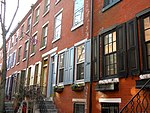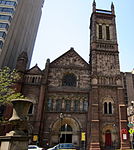Academy of Vocal Arts

The Academy of Vocal Arts (AVA) is a school dedicated to providing higher education to aspiring opera singers. It is the only tuition-free institution in the world devoted solely to operatic training and performance. The school was founded in 1934 by Helen Corning Warden and is located at 1920 Spruce Street in Philadelphia, Pennsylvania. Notable alumni include Lando Bartolini, Harry Dworchak, and Ruth Ann Swenson. The institution maintains a Hall of Fame for Great American Opera Singers which The Opera Quarterly described as equivalent to the kammersänger title in Europe. Some of the artists in the AVA's Hall of Fame include John Alexander, Rose Bampton, Lili Chookasian, Phyllis Curtin, Frank Guarrera, John Macurdy, Rosa Ponselle, Eleanor Steber, Jess Thomas, Jon Vickers, and Beverly Wolff.
Excerpt from the Wikipedia article Academy of Vocal Arts (License: CC BY-SA 3.0, Authors, Images).Academy of Vocal Arts
Spruce Street, Philadelphia Center City
Geographical coordinates (GPS) Address Nearby Places Show on map
Geographical coordinates (GPS)
| Latitude | Longitude |
|---|---|
| N 39.94793 ° | E -75.17371 ° |
Address
Spruce Street
19103 Philadelphia, Center City
Pennsylvania, United States
Open on Google Maps









